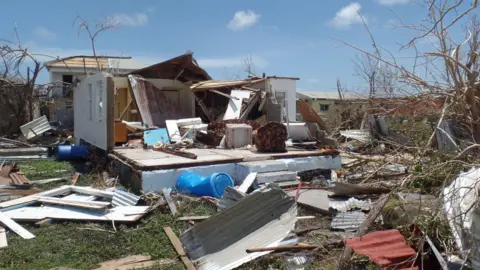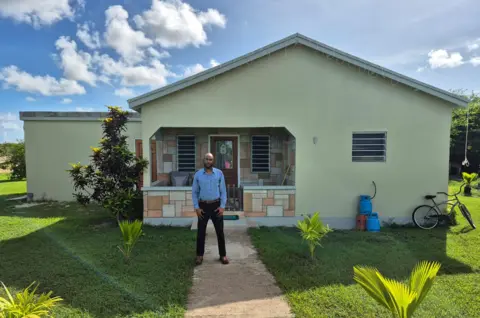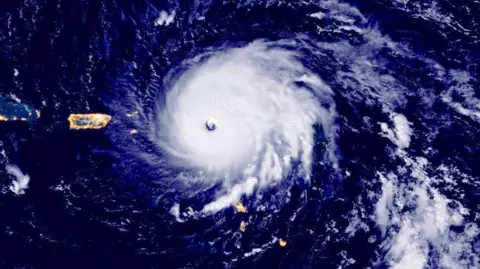Business
Hurricane season brings financial fears in the Caribbean

Gemma HandyBusiness reporter, St Johns, Antigua
 Getty Images
Getty ImagesFor some Barbudans, thunderstorms still trigger flashbacks of the night in September 2017 when they lost everything they owned to Hurricane Irma’s devastating winds.
Eight years on, while memories may be close to hand, home insurance for many on Barbuda and other islands in the Caribbean’s hurricane belt is more prohibitively expensive than ever.
Across the region premiums have gone through the roof in the past two years, surging by as much as 40% on some islands, according to industry figures.
Experts blame a perfect storm of increasing risk – as the region sees worsening and more rapidly intensifying cyclones – yet tiny populations of people to pay for policies, equating to poor returns for insurance companies.
Dwight Benjamin’s Barbuda home was one of few left relatively undamaged by Irma. After the storm, he invested in a one-room extension topped with a concrete roof that will serve as a shelter for his family should disaster strike again.
“I think the house should be sound enough but that’s my added protection,” he says.
With peak hurricane season now in full swing, Dwight is among many Caribbean people anxiously monitoring weather platforms for activity in the Atlantic. Should a system head his way, he will do as he did during Irma – hope and pray.
“I’ve never had insurance; most Barbudans don’t really think it’s worth it. It’s just an added expense to the meagre resources we have,” he explains.
“Plus, we believe in what we have built and that it should be able to withstand the weather.”
 Courtesy Dwight Benjamin
Courtesy Dwight BenjaminLike Dwight, many Caribbean people build homes “out of pocket”, rather than opting for mortgages that can have high interest rates in this part of the world.
And the majority of homes on islands affected by hurricanes are uninsured. In Jamaica only 20% are reported to have cover, and just half in Barbados.
It is not just storms threatening the region, but earthquakes and volcanos too, points out Peter Levy, boss of Jamaican insurance company BCIC.
As a result of these threats of natural disaster, which Mr Levy calls the Caribbean’s “unique market”, the cost of home insurance will always be high.
One Antiguan insurance firm, Anjo, typically charges premiums of between 1.3% and 1.7% of a home’s value. Whereas in the UK, for example, it can be less than 0.2%.
 Getty Images
Getty ImagesThe Atlantic hurricane season runs from 1 June to 30 November, with the most activity occurring between mid-August and mid-October. The northern Caribbean nations, such as Antigua and Barbuda, the Bahamas, British Virgin Islands, and the Dominican Republic, are among the most at risk of a direct hit.
The peak months can be torturous for people with Irma-related trauma, says Mohammid Walbrook, another Barbudan resident. “Whenever there’s an announcement of a storm coming our way, it brings back bad memories. For some, even thunder and lightning are a trigger,” he says.
Back in 2017, Mohammid took shelter in a bathroom with his mother, father, sister and nephews when Irma’s category five winds tore the roof from his parents’ home.
His own uninsured two-bedroom property was also badly damaged. He was one of several Barbudans to receive a new house through assistance from international donors.
 Courtesy Mohammid Walbrook
Courtesy Mohammid WalbrookWhile some Caribbean countries – like British territory Turks and Caicos, also battered by Irma – have emergency cash reserves that can help with post-storm restoration, others do not have that luxury.
For deeply indebted nation Antigua and Barbuda, agencies like the United Nations Development Programme (UNDP) are a lifeline in the aftermath of a natural disaster.
The country’s prime minister Gaston Browne estimated the cost of rebuilding Barbuda after Irma, where 90% of buildings were damaged, topped $200m (£148m). Help came from China, the European Union and Venezuela, among others.
In 2017, the UNDP stumped up $25m for Barbuda and the island country of Dominica, which was ravaged by Hurricane Maria that same month.
The money restored more than 800 wrecked buildings across the two islands. But the body’s intervention was crucial in other ways too.
With livelihoods destroyed, the UNDP’s cash-for-work programme hired hundreds of local residents who had suddenly found themselves unemployed.
They assisted with everything from debris removal to reconstruction of homes and infrastructure, including Barbuda’s hospital and post office, the UNDP’s Luis Gamarra tells the BBC.
“Injecting economic resources into affected families helps reactivate the local economy,” he says.
Almost 1,000 contractors were also trained in more resilient “build back better” techniques, to safeguard structures against future disasters.
“The climate is changing and putting more pressure on governments and communities. Storms are becoming more frequent, more intense and happening earlier in the year too,” Mr Gamarra continues.
He thinks the expansion of partnerships with the private sector and with other countries in the region might help mitigate the impacts.
One such mechanism is the Caribbean Catastrophe Risk Insurance Facility, of which 19 Caribbean governments are members. Set up after Hurricane Ivan in 2004, the first-of-its-kind risk-pooling venture allows member governments to buy disaster coverage at low cost.
Last year it made record payments topping $85m to Hurricane Beryl-hit islands.
In Antigua and Barbuda, hurricane preparedness is a year-round endeavour, explains Sherrod James, director of the country’s office of disaster services.
Assessments of buildings to be used as storm shelters, along with training of volunteers to man them, starts months before the season starts, he says.
“We also meet with the private sector, helping them put policies and preparations in place, looking at the safety and resilience of their buildings. We make sure our critical partners, such as the ports, are prepared.
“And we do a lot of proactive work to address chokepoints within waterways that can exacerbate flooding,” adds Mr James. “These days, storms can go from a category one to five in a day. The new norm has thrown out the old regiment of what has to be done; we have to be much more proactive now.”
For many Barbudans, this time of year will always bring trepidation. Dwight was among dozens who recently attended a Hurricane Irma remembrance service at the island’s Pentecostal Church.
“It was very touching and brought back a lot of memories,” he says. “This time of year, we keep an eye on the weather and our fingers crossed. But we are resilient people and we know how to survive.”
Business
Cloud infra deal: Microsoft partners with Anthropic and Nvidia; $45 billion cloud deal to reshape AI infrastructure – The Times of India

Microsoft on Tuesday announced a sweeping cloud infrastructure partnership with artificial intelligence firm Anthropic and chipmaker Nvidia, marking a significant realignment in the technology giant’s AI alliances as it moves further away from exclusive dependence on OpenAI, AP reported.Anthropic, the developer of rival chatbot Claude, said it will commit to purchasing $30 billion worth of computing capacity from Microsoft’s Azure cloud platform under the new agreement. As part of the same partnership, Nvidia will invest up to $10 billion in Anthropic, while Microsoft will invest up to $5 billion in the San Francisco-based company.The joint announcement from Anthropic CEO Dario Amodei, Microsoft CEO Satya Nadella and Nvidia CEO Jensen Huang was made just before the opening of Microsoft’s annual Ignite developer conference.Microsoft had long served as OpenAI’s exclusive cloud provider, but that arrangement began to shift earlier this year. While the two companies continue to collaborate, OpenAI has expanded its cloud strategy by striking major deals with Oracle, SoftBank and other chipmakers and data-centre operators to secure additional computing capacity.The latest move strengthens Microsoft’s position in the rapidly intensifying AI infrastructure race and gives Anthropic access to one of the world’s largest cloud ecosystems as competition with OpenAI accelerates.
Business
Property Prices Have Surged 500% In These Religious Cities, NCR Realtors Enter The Market

Last Updated:
Bolstered by the popularity of Premanand Maharaj and the Banke Bihari Temple Corridor, Varanasi’s land prices have gone from Rs 20,000 per 900 sq ft to Rs 1 crore in just 4 years
Ayodhya land prices increased 50-100% due to Ram Temple construction.
In a striking shift from the traditional focus on metro and tier-1 cities, the real estate landscape is witnessing a new trend as pilgrimage and religious cities are becoming prime destinations for homebuyers and investors. Cities such as Ayodhya, Varanasi, Prayagraj, Vrindavan, and Haridwar are seeing a surge in property demand, with some areas experiencing price jumps of up to 500%.
Experts attribute this boom to a combination of religious tourism, major infrastructure projects, and increased economic activity in these cities. “The construction of the Ram Temple in Ayodhya, the Kashi Corridor in Varanasi, and major festivals like the Maha Kumbh have attracted a growing number of devotees,” said a property analyst. He said that the rise in footfall is directly influencing real estate, with demand for second homes, retirement properties, and serviced apartments at an all-time high.
Vrindavan: Prices Jump 500%
Vrindavan has emerged as one of the most expensive religious real estate markets in the country. The city’s growing prominence, bolstered by the popularity of Saint Premanand Maharaj and the Banke Bihari Temple Corridor, has seen land prices escalate from Rs 20,000 per 100 square yards to over Rs 1 crore in just four years in approved residential projects like Rukmini Vihar. Developers such as Omaxe, Basera, and Amaiya are actively launching high-rise residential and commercial projects, including Omaxe Krishna Crest, Omaxe Eternity, and Omaxe Bettgather Courtyard Mall, catering to the surge in demand.
Ayodhya: Land Prices Soar 50-100%
Ayodhya has witnessed a dramatic rise in property rates since the construction of the Ram Temple started. Land surrounding the temple has seen prices climb by 50-100%, prompting developers to plan theme-based townships and modern residential projects. Local developer Ayodhya Home & Soul Developers is reportedly preparing to launch a significant residential project in the city. Improved infrastructure and government-backed initiatives are further enhancing returns, making Ayodhya a hotspot for investors and homebuyers alike.
Prayagraj: From Industrial Hub to Real Estate Attraction
The Naini area in Prayagraj is rapidly transforming, driven by its emergence as both an industrial and educational hub. Developers, including Omaxe, are establishing large residential projects such as Omaxe Sangam City and Omaxe Ananda, shifting the market from traditional low-rise housing to high-rise developments.
Dehradun: Penthouses and Luxury Apartments in Demand
In Dehradun, Sahastradhara Road and Rajpur Road, along with areas near Tapkeshwar Mahadev and Drone Cave Temples, are witnessing growing real estate interest. Projects like Sikka Kimaya Greens and Excentia Tatva are introducing luxury apartments, high-rises, and penthouses, merging modern amenities with serene surroundings. Excentia Tatva, in particular, is being promoted as the city’s first uber-luxury residential experience.
Varanasi: A Rising Hub for Real Estate Investment
Varanasi continues to attract Shiva devotees and investors alike, with both residential and commercial properties seeing heightened interest. Improved connectivity and growing religious tourism are factors driving the city’s rising property prices.
Why Religious Cities Are Gaining Momentum
Several factors underpin this new trend:
- Religious tourism is seeing record growth, drawing lakhs of devotees annually.
- Enhanced highway, rail, and air connectivity makes these cities more accessible.
- Rising demand for retirement homes and second residences is fueling development.
- Branded developers from Delhi-NCR and other major cities are entering these markets.
- Government support and infrastructure projects are boosting investor confidence.
As spiritual hubs evolve into real estate hotspots, these cities are no longer just centres of faith, they are emerging as strong, high-return investment destinations.
November 18, 2025, 20:04 IST
Read More
Business
Govt To Notify New ITR Forms By January 2026, Implement Them From April

New Delhi: The Income Tax Department will notify new income‑tax return (ITR) forms and related rules under the streamlined Income Tax Act, 2025, by January, and the updated regulations be effective from April 1, 2026. The updated regulations will mark the transition from the nearly six-decade old Income Tax Act of 1961, multiple reports cited Central Board of Direct Taxes chairman Ravi Agrawal as saying.
Agrawal said the department is designing the new forms keeping it simple and easy to comply and adapt to. “We are in the process of designing the new forms and rules, and our aim is to notify them by January so that taxpayers have adequate time to adjust their systems and processes,” he was quoted as saying at the inauguration of Taxpayers’ Lounge at the India International Trade Fair (IITF) here.
Analysts said that the current framework of the rules is largely drafted in traditional legal language making it hard to understand and interpret. They said new rules should use simplified language, include illustrations for valuation rules, and align form structure with revamped TDS provisions under the new Income-tax Act 2025.
The Taxpayers’ Lounge offer a wide range of assistance and interactive resources that help with PAN/e‑PAN applications, Aadhaar–PAN linking and resolving PAN-related queries. Further, it will offer support for e‑filing, Form 26AS queries, TDS issues, guidance on international taxation, faceless assessment and appeals, and and other online filing issues.
Agrawal added that the Income Tax Department will release outstanding tax refunds by December. “We have analysed and found that some wrong refunds or deductions were being claimed so there is scrutiny, but we hope to release the remaining refunds by this month or December,” he added.
-

 Tech1 week ago
Tech1 week agoFrom waste to asset: Turning ethanol production CO₂ into jet fuel
-

 Tech3 days ago
Tech3 days agoNew carbon capture method uses water and pressure to remove CO₂ from emissions at half current costs
-

 Politics5 days ago
Politics5 days agoBritish-Pakistani honoured for transforming UK halal meat industry
-

 Sports3 days ago
Sports3 days agoTexas A&M officer scolds South Carolina wide receiver after touchdown; department speaks out
-

 Business3 days ago
Business3 days agoThese 9 Common Money Mistakes Are Eating Your Income
-

 Tech1 week ago
Tech1 week agoSecurity flaws in portable genetic sequencers risk leaking private DNA data
-

 Politics5 days ago
Politics5 days agoInternet freedom declines in US, Germany amid growing online restrictions
-

 Fashion4 days ago
Fashion4 days agoAfter London, Leeds and Newcastle, next stop Glasgow for busy Omnes







